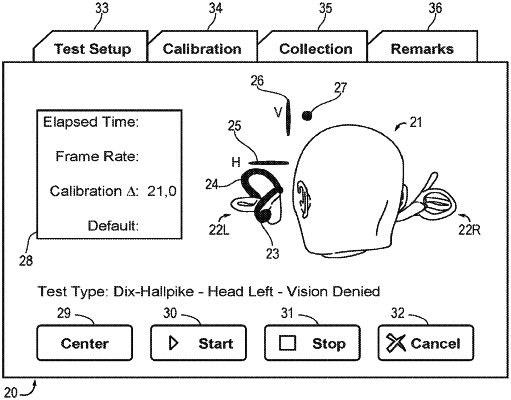| CPC A61B 5/1128 (2013.01) [A61B 5/1114 (2013.01); A61B 5/7275 (2013.01); A61B 5/7445 (2013.01); G16H 30/40 (2018.01); G16H 40/63 (2018.01); A61B 3/113 (2013.01)] | 16 Claims |

|
1. A system for detecting and recording head orientations of a person, comprising:
a data acquisition system configured for storing and outputting sensor data from a first sensor device and additional sensor data from a second sensor device;
a calculation module that receives streams of real time sensor data representing gaze direction and spatial orientation of the head of the person from the data acquisition system and converts the real time data into a horizontal movement vector, a vertical movement vector and a rotational movement vector representing spatial orientation and vestibular activity in the person; and
a processor configured for generating an image for presentation by a graphical display, the image comprising:
a first reference indicator;
a second reference indicator;
a set of left canals;
a set of right canals;
an orientation indicator, and
a feedback indicator for providing a feedback when a first condition is met.
|
|
10. A system for detecting and recording head orientations of a person, comprising:
a calculation module that receives streams of real time sensor data representing gaze direction and spatial orientation of the head of the person from a medical data acquisition system, and converts real time data into a horizontal head movement vector, a vertical head movement vector and a rotational head movement vector representing spatial orientation and vestibular activity in the person;
a processor configured for generating an image for presentation by a graphical display, the image comprising a first reference indicator, a second reference indicator, a set of left canals, a set of right canals, and an orientation indicator; and
a feedback indicator for providing a feedback when a first condition is met.
|
|
13. A system for detecting and recording head orientations of a person, comprising:
a first sensor device capable of providing sensor data regarding a head orientation of a person in a three-dimensional space;
a second sensor device capable of providing an additional sensor data regarding an eye movement of the person;
a data acquisition system configured for storing and outputting the sensor data from the first sensor device and the additional sensor data from the second sensor device;
a memory configured for storing a three-dimensional model of a human head and canals of the person;
a calculation module that receives streams of real time sensor data representing gaze direction and spatial orientation of the head of the person from the data acquisition system, and converts the real time data into a horizontal movement vector, a vertical movement vector and a rotational movement vector representing spatial orientation and vestibular activity in the person, defining real time vector data; and
a processor configured for processing and combining the real time vector data from the calculation module with the three-dimensional model of the human head and the canals stored in the memory, outputting a first signal representing the head orientation, generating an image having a two-dimensional projection of the three-dimensional model of the human head for presentation by a graphical display, and generating a viewing angle of the two-dimensional projection of the three-dimensional model of the human head is determined based on the first signal representing the head orientation; and wherein the first condition is met when the head orientation represented by the first signal deviates more than a predetermined amount from a desired orientation according to a maneuvering scheme
generating an image comprising a first and a second reference indicators, a left and a right canal, an orientation indicator, and a feedback indicator.
|